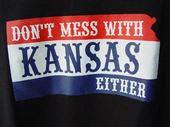Click Here For The HOTTEST Myspace LayoutsBlue hot in topeka full length
Add to My Profile | More Videos On December 5, 1854, nine men made the wintery trek from the tent city of Lawrence to a small log cabin on the banks of the Kansas River. Huddled in the cold before a smoky fire, this group of men founded a town that became the capital of the 34th state in the union and would play a significant role in American history.The city of Topeka was incorporated on February 14, 1857. Cyrus K. Holliday is widely regarded as the "father" of Topeka and served as the city’s first mayor. He later drafted the charter for the Atchison, Topeka and Santa Fe railway, known today as the Burlington Northern and Santa Fe Railway."Bleeding Kansas," a prelude to the Civil War, was a decade of abolitionist and pro-slavery conflict in Kansas during the 1850s. Topekans such as John Ritchie battled for the abolition of slavery as Kansas approached statehood. Ritchie's south Topeka home became a meeting place for the free-state faction and a station on the Underground Railroad. Ritchie's wife, Mary Jane, served as the leader of Kansas' early women's suffrage movement, hosting Susan B. Anthony and Elizabeth Cady Stanton. Ritchie's home, at 1116 South Madison, is noted as Topeka's oldest house.On January 29, 1861, Kansas was admitted as the 34th state of the union, and Topeka was chosen as the state capital. Dr. Charles Robinson served as the first governor of Kansas. Cyrus K. Holliday, Topeka’s founding father, donated a tract of land to the state for the construction of a new state capitol. The building was complete in 1903.Cyrus K. Holliday drafted the charter and a decade later staged the groundbreaking of the Atchison, Topeka and Santa Fe railroad. Topeka's central location served as the perfect hub as the railways expanded westward. Burlington Northern and Santa Fe has been one of Topeka's major industries for over a century. Union Pacific began operating in Topeka in 1866, and Rock Island Railroad followed in 1887.Education has played a major role in Topeka’s history from the beginning. The Episcopal Church established the College of the Sisters of Bethany in 1860. Advertised as the "Wellsley of the West," it provided an excellent education for young ladies at a time when such opportunities were rare.Lincoln College was established in 1865 by the State of Kansas and the General Association of Congregational Ministers and Churches of Kansas. Col. John Ritchie (see “Bleeding Kansasâ€) donated the 160-acres of land for construction. In 1868, the college was named Washburn. Eventually Washburn became a municipal university and is the last city-chartered university in the United States. The facility was largely rebuilt in 1966 after a tornado destroyed much of the campus.Topeka was the home of the Oliver Brown family, the namesake in Brown v. Board of Education case, a landmark Supreme Court decision that eliminated the "separate but equal" standard in American public schools. It is interesting to note that only the elementary schools in Topeka were segregated at that time. Topeka High School had been fully integrated since its inception in the late 1890s.
